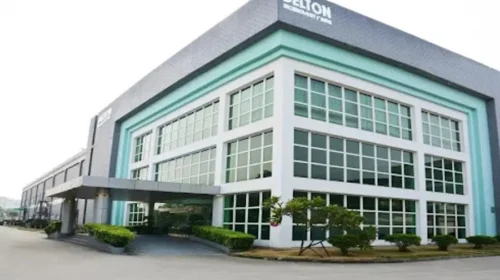Sinking SICC looks for lift from Hong Kong IPO

The maker of silicon carbide substrates has been cleared by China’s securities regulator to list in Hong Kong, even as its revenue began to contract in the first quarter
Key Takeaways:
- The Chinese securities regulator has registered an IPO plan by semiconductor firm SICC, clearing the way for its listing to proceed in Hong Kong
- After reporting strong revenue gains in 2023, the SiC substrate maker’s growth slowed sharply last year and began to contract in the first quarter of 2025
By Doug Young
What a difference four months makes.
When semiconductor company SICC Co. Ltd. (688234.SH) first filed to list in Hong Kong back in February, it was boasting strong double-digit revenue growth and was on track to report its first annual profit. The company’s Hong Kong listing, which was just approved by China’s securities regulator on Friday, would complement its existing listing on Shanghai’s STAR Market.
The listing plan’s registration by the China Securities Regulatory Commission (CSRC) officially clears the way for SICC to sell shares into one of the hottest Hong Kong IPO markets in years. It plans to sell 87.2 million shares in the listing, according to the CSRC registration statement.
The listing is being underwritten by two of China’s largest investment banks, CICC and Citic Securities, indicating it will mostly target Asian investors. That’s not too surprising, since the West – and the U.S. in particular – are increasingly taking steps to ban their investors from buying shares in Chinese makers of cutting-edge technologies, including microchips that are used in many high-tech gadgets, but also have defense applications.
SICC’s Hong Kong listing plan looked relatively attractive when it first filed its application in February, and updated the application a month later. But since that application, which only included its financial information through the end of last September, its business has headed into a tailspin.
The company and its peers are being pummeled on a couple of fronts. SICC makes silicon carbide (SiC) substrates, which are the foundation used to make wafers that are ultimately carved into microchips. SICC’s chips are used by a wide range of industries, but two of the biggest are the solar power equipment and new energy vehicle (NEV) makers.
In a situation that’s all too common, SICC and its peers have built up huge capacity in the last few years to feed the booming solar energy and NEV sectors. That has resulted in overcapacity that is quite common in cutting-edge Chinese industries these days, undermining prices for the SiC substrates that account for more than 80% of SICC’s sales.
Similar overcapacity in the NEV and solar power sectors is the other factor that’s causing major headaches for SICC and its peers.
After posting strong double- and even triple-digit sales gains for the last two years, Chinese NEV manufacturers are suddenly seeing their growth slow sharply as the domestic market becomes saturated and foreign markets erect trade barriers to Chinese imports. The resulting price wars have caused NEV makers’ losses to widen, making them pressure their suppliers for lower prices. The situation is similar for solar panel makers, many of which have slipped into the red as their production costs exceed tanking panel prices.
The price pressure was already evident in SICC’s March listing application, though the effects appear to have worsened since then. The company said the average price for each of its SiC substrates was 4,185 yuan ($583) in the first nine months of last year, down from 4,798 yuan for all of 2023 and nearly 20% lower than 5,110 yuan it was getting in 2022. But its cost of sales have continued to climb steadily, growing 34% from 710 million yuan in the first nine months of 2023 to 954 million yuan in the same period of last year.
Revenue slips into contraction
SICC’s original IPO application looked quite attractive, showing the company’s revenue tripled in 2023 from the previous year as demand from the NEV and solar sectors boomed, and the company began mass production of its latest 8-inch substrates. Founded in 2010, SICC started out making 2-inch substrates, and added 4-inch and 6-inch products in 2015 and 2021, respectively. The larger a substrate, the higher its yield of microchips.
The company said it developed its first 12-inch SiC substrates last year, though those products have yet to go into mass production.
SICC wasn’t the only company rolling out new products and boosting capacity, even as two of its largest customer groups were starting to show signs of distress last year. As those things happened, the company’s growth slowed sharply in 2024, though it still looked respectable as its revenue rose 55% year-on-year in the nine months through September to 1.28 billion yuan.
That slowdown accelerated in last year’s fourth quarter, as the company’s revenue growth fell to just 14.3%, according to calculations using data from the listing document and full-year data from SICC’s filings to the Shanghai Stock Exchange. That trend worsened in the first quarter of this year, as the company’s revenue fell 4.25% to 408 million yuan from 426 million yuan a year earlier, according to its first-quarter report filed to the Shanghai Stock Exchange.
The company’s margins and profits have followed similar trajectories. Its gross margin turned positive in 2023 at 14.6%, and rose further to 25.5% in the first nine months of last year. Similarly, it climbed out of the red by posting a 143 million yuan profit in the first nine months of last year, compared with a 68.2 million yuan loss in the year-ago period. But the company’s profit plunged 82% to 8.52 million yuan in the first quarter of this year from 46.1 million a year earlier, suggesting it could slip back into the red later this year.
SICC said increased R&D spending was partly behind the profit plunge, and, indeed, such spending rose to 11% of revenue in this year’s first quarter from 5.2% a year earlier.
SICC’s stock hasn’t been a stellar performer since its Shanghai listing in 2022. The shares briefly traded nearly 50% higher than their IPO price shortly after the listing, but have given back all those gains and more since then. They now trade about 30% below their IPO price, following a selloff after it announced the worrisome first-quarter results.
Its less-than-stellar results are unlikely to excite investors, especially as SICC competes with a number of other similar companies for attention in Hong Kong. Those include InnoScience (2577.HK), whose shares are up about 20% since their trading debut at the end of last year, as well as Guangdong Tianyu Semiconductor and Epiworld International, which are both also aiming to list in Hong Kong.
To subscribe to Bamboo Works weekly free newsletter, click here




